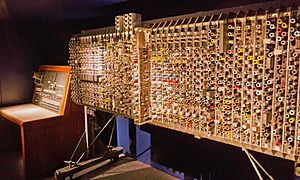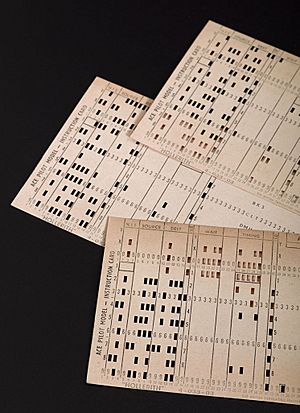Automatic Computing Engine facts for kids
The Automatic Computing Engine (ACE) was an early British computer design. It was created by the famous mathematician Alan Turing in 1945. Turing had already worked on the secret Colossus computer during World War II.
The full ACE computer was never built. But a smaller version, called the Pilot ACE, was made in 1950. It was built at the National Physical Laboratory (United Kingdom). Another larger computer based on the ACE design was called MOSAIC. It started working in 1955. The ACE design also helped create other computers, like the Bendix G-15.
How the ACE Computer Started
The ACE project was led by John R. Womersley. He was in charge of the Mathematics Division at the National Physical Laboratory (NPL). The name "Engine" was chosen to honor Charles Babbage. He designed early mechanical computers like the Difference Engine.
Alan Turing joined the NPL in 1945. By the end of that year, he finished his plans for the "Proposed Electronic Calculator." This was a very detailed design for a stored-program computer. It was much bigger than the final working machines. Turing's ideas came from his 1936 paper "On Computable Numbers." In this paper, he described a "universal computing machine." Today, we call this a Universal Turing machine.
Turing also used his experience from Bletchley Park. There, the Colossus computers helped break German secret codes. Because of strict secrecy laws, Turing could not explain how his ideas could be built using electronics. Another computer design, the EDVAC, became well-known. It was designed by John von Neumann in 1945.
Turing's report on the ACE included detailed diagrams. It also estimated the cost to be about £11,200. He believed that speed and memory size were very important. He suggested a fast memory of about 25 kilobytes. This memory would work at 1 MHz. He said that memory was the main challenge in building a computer. The ACE design also used "Abbreviated Computer Instructions." This was an early form of a programming language.
Pilot ACE
Turing's co-workers at the NPL thought building the full ACE was too big a task. So, they built a smaller version called the Pilot Model ACE. Turing's assistant, Jim Wilkinson, worked on the design. When Turing left in 1947, Wilkinson took over the ACE group.
The Pilot ACE used fewer than 1,000 vacuum tubes. The famous ENIAC computer, for example, used about 18,000. The Pilot ACE used mercury delay lines for its main memory. Each of its 12 delay lines was 5 feet (1.5 meters) long. They could hold 32 instructions or data words.
The Pilot ACE ran its first program on May 10, 1950. At that time, it was the fastest computer in the world. Each delay line could process 1 Mbit per second. Later, commercial versions of the Pilot ACE were made. These were called the English Electric DEUCE. About 31 of these were sold starting in 1955.
MOSAIC
Another computer based on the ACE design was called MOSAIC. This name stood for "Ministry of Supply Automatic Integrator and Computer." It was built by Allen Coombs and William Chandler. They had worked on the Colossus computers during the war.
MOSAIC was installed at the Radar Research and Development Establishment (RRDE) in Malvern. It ran its first test program in late 1952 or early 1953. It became fully operational in early 1955. MOSAIC had 6,480 electronic valves. It was available to use about 75% of the time. It took up four rooms and was one of the largest early British computers. MOSAIC was used to figure out where aircraft were going based on radar data. It kept working until the early 1960s.
Other Computers Based on ACE
The ideas from the ACE design were used in other computers. One example is the Bendix Corporation's G-15 computer. Harry Huskey worked on its design. He had spent time in the ACE section at the NPL in 1947.
The first G-15 ran in 1954. It was a smaller computer designed for one user. Some people consider it to be one of the first personal computers. Other computers that came from the ACE design include the EMI Electronic Business Machine and the Packard Bell Corporation PB 250.
See Also
- Pilot ACE
- MOSAIC (computer)



